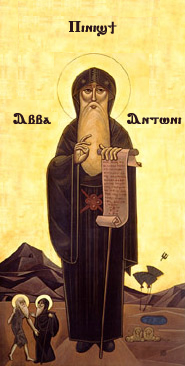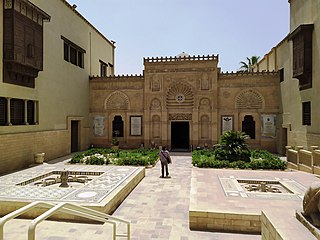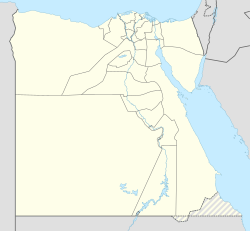
Anthony the Great was a Christian monk from Egypt, revered since his death as a saint. He is distinguished from other saints named Anthony, such as Anthony of Padua, by various epithets: Anthony of Egypt, Anthony the Abbot, Anthony of the Desert, Anthony the Anchorite, Anthony the Hermit, and Anthony of Thebes. For his importance among the Desert Fathers and to all later Christian monasticism, he is also known as the Father of All Monks. His feast day is celebrated on 17 January among the Eastern Orthodox and Catholic churches and on Tobi 22 in the Coptic calendar.

Pachomius, also known as Saint Pachomius the Great, is generally recognized as the founder of Christian cenobitic monasticism. Coptic churches celebrate his feast day on 9 May, and Eastern Orthodox and Catholic churches mark his feast on 15 May or 28 May. In Lutheranism, he is remembered as a renewer of the church, along with his contemporary, Anthony of Egypt on 17 January.
A monastery is a building or complex of buildings comprising the domestic quarters and workplaces of monastics, monks or nuns, whether living in communities or alone (hermits). A monastery generally includes a place reserved for prayer which may be a chapel, church, or temple, and may also serve as an oratory, or in the case of communities anything from a single building housing only one senior and two or three junior monks or nuns, to vast complexes and estates housing tens or hundreds. A monastery complex typically comprises a number of buildings which include a church, dormitory, cloister, refectory, library, balneary and infirmary and outlying granges. Depending on the location, the monastic order and the occupation of its inhabitants, the complex may also include a wide range of buildings that facilitate self-sufficiency and service to the community. These may include a hospice, a school, and a range of agricultural and manufacturing buildings such as a barn, a forge, or a brewery.
A lavra or laura is a type of monastery consisting of a cluster of cells or caves for hermits, with a church and sometimes a refectory at the center. Lavra monasteries operate within the Orthodox and other Eastern Christian traditions; the name is also used by some Catholic communities. The term in Greek initially meant a narrow lane or an alley in a city. In a later Eastern Orthodox context, the term took the new meaning of large and important monastery.

Macarius of Egypt was a Christian monk and grazer hermit. He is also known as Macarius the Elder or Macarius the Great.

Christian monasticism is a religious way of life of Christians who live ascetic and typically cloistered lives that are dedicated to Christian worship. It began to develop early in the history of the Christian Church, modeled upon scriptural examples and ideals, including those in the Old Testament. It has come to be regulated by religious rules and, in modern times, the Canon law of the respective Christian denominations that have forms of monastic living. Those living the monastic life are known by the generic terms monks (men) and nuns (women). The word monk originated from the Greek μοναχός, itself from μόνος meaning 'alone'.

Wadi El Natrun is a depression in northern Egypt that is located 23 m (75 ft) below sea level and 38 m (125 ft) below the Nile River level. The valley contains several alkaline lakes, natron-rich salt deposits, salt marshes and freshwater marshes.

The Monastery of Saint Macarius The Great also known as Dayr Al-ʾanbā Maqār is a Coptic Orthodox monastery located in Wadi El Natrun, Beheira Governorate, about 92 km (57 mi) north-west of Cairo, and off the highway between Cairo and Alexandria.

The Monastery of Saint Pishoy, also known as Saint Pishoy Monastery, is a Coptic Orthodox monastery in Wadi El Natrun, west of the Nile Delta in northern Egypt. It is the largest active monastery in the region and is currently headed by Bishop Anba Agabius. Founded in the late 4th century AD by Saint Pishoy, a disciple of Saint Macarius, the monastery serves as a prominent religious and monastic site.

Paromeos Monastery, also known as Baramos Monastery, is a Coptic Orthodox monastery located in Wadi El Natrun in the Nitrian Desert, Beheira Governorate, Egypt. It is the most northern among the four current monasteries of Scetis, situated around 9 km northeast of the Monastery of Saint Pishoy. Ecclesiastically, the monastery is dedicated to and named after the Virgin Mary.

Eastern Christian monasticism is the life followed by monks and nuns of the Eastern Orthodox Church, Oriental Orthodoxy, the Church of the East and some Eastern Catholic Churches.

The Monastery of Saint Anthony is a Coptic Orthodox monastery standing in an oasis in the Eastern Desert of Egypt, in the northern part of the Red Sea Governorate close to the border with the Suez Governorate.

Coptic architecture is the architecture of the Coptic Christians, who form the majority of Christians in Egypt.

Coptic monasticism was a movement in the Coptic Orthodox Church to create a holy, separate class of person from layman Christians.

Chariton the Confessor was an early Christian monk. He is venerated as a saint by both the Western and Eastern Churches. His remembrance day is September 28.
Saint Matthew the Potter, also known as Saint Matthew the Poor, is an Egyptian Christian saint of the 8th century. He was contemporary of Pope Alexander II of Alexandria. According to Abu al-Makarim, Saint Matthew the Potter may have also been Coptic Orthodox bishop of the city of Esna. He is the founder of the Monastery of Saint Matthew the Potter.
Isaiah the Solitary, also known as Isaiah of Gaza, Isaias the Solitary, Abba Isaiah, or possibly also Isaiah of Scetis, was a Christian ascetic and monastic writer known from the Sayings of the Desert Fathers and various Palestinian Miaphysite sources. He is canonized as a saint by the Coptic Orthodox Church, with his feast day on the 11th day of the month Abib (Epip) in the Coptic calendar.
Mount Colzim, also known as the Inner Mountain of Saint Anthony, is a mountain in Red Sea Governorate, Egypt, which was the final residency of Anthony the Great from about AD 311, when he was 62 years of age, to his death in 356. Currently, the Monastery of Saint Anthony, a Coptic Orthodox monastery, exists in the same location.
Tbew was an Egyptian Coptic Orthodox monastery that was established in the mid-4th century. It was one of the Pachomian monasteries.





















